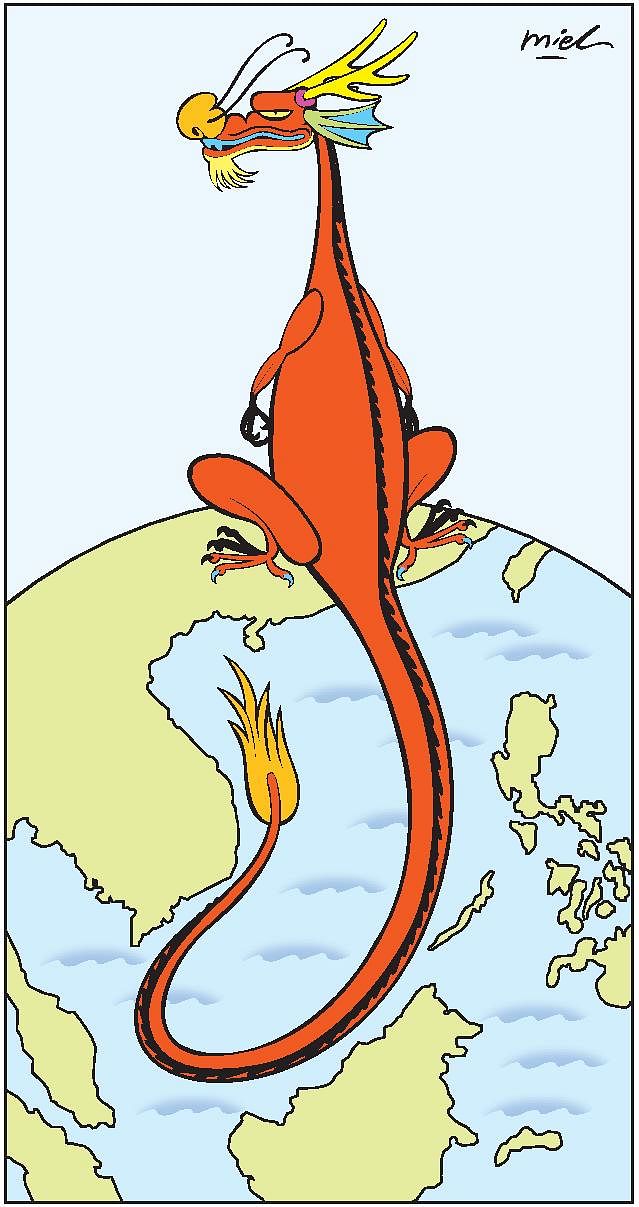Any day now the Permanent Court of Arbitration in The Hague will hand down its judgment in the case brought by the Philippines about the validity of some of China's claims in the South China Sea.
Attention is focused mostly on the tribunal's ruling on Beijing's claim to some kind of ill-defined ownership of all the waters that lie within the famous "nine-dash line".
The judgment has been eagerly awaited by those in the region and beyond - especially in Washington - who hope and expect to see China's claims rejected by the court. But what difference will the judgment make, even assuming - as most experts do - that it will go against China on the key issues? Beijing has refused to acknowledge the court's jurisdiction, took no part in the hearings, and has repeatedly declared that it will ignore its findings.
Would that do China any harm? America, with its friends and allies, think that a formal ruling by an internationally recognised court will increase the moral and diplomatic pressure on China to cease pressing its territorial and maritime claims so assertively. Washington seems convinced that faced with a negative judgment, Beijing would finally decide that the diplomatic damage to its standing in South-east Asia has become unbearable.
But the most recent evidence all points the other way. A couple of weeks ago, China apparently forced Asean foreign ministers into a highly embarrassing retraction of a relatively mildly worded joint statement alluding to the South China Sea as "an issue in the relations and cooperation between Asean and China". The statement was hurriedly withdrawn just three hours after it was issued. That hardly suggests that China feels the need to start lowering the diplomatic temperature.
Then last week, China allowed tensions to escalate with South-east Asia's most important power, Indonesia. Beijing vigorously protested against Indonesia's robust response to Chinese fishing vessels operating in what Jakarta claims is Indonesia's Exclusive Economic Zone around the Natuna Islands, but which also fall within Beijing's nine-dash line claim.

China's reaction in turn prompted surprisingly stern actions from Indonesia. President Joko Widodo ordered the Indonesian National Armed Forces (TNI) to deploy more forces to the region and made a high-profile visit there himself with senior Cabinet ministers to underline Jakarta's seriousness. But Beijing doesn't seem too worried.
Again, there is no sign here that China's leaders are starting to feel the diplomatic pressure.
And that raises the obvious question: What happens next if China simply ignores the court's ruling? In particular, what does Washington do? Clearly Washington is prepared for trouble. Over the last few months, it has responded to what it sees as Beijing's destabilising militarisation of the situation by sending substantial new forces of its own into the region. This has culminated in the deployment of two US aircraft carrier strike groups off the Philippines in recent days.
This is the biggest overt display of American military power in the Western Pacific since it sent two carriers to face down China in the Taiwan Crisis of 1996. It is plainly intended to send an unmistakable message of Washington's resolve.
But resolve to do what, exactly?
Let's look at two scenarios. In one, China does nothing more in response to the court's judgment than issue a strongly worded rejection. It does not back off from anything it has been doing, but takes no immediate, overt additional steps to expand its presence or strengthen its position in the contested areas. In this case, without any provocative Chinese actions to respond to, it is hard to see what America could do with all the military force it has assembled.
In the other scenario, China decides it has to make a more forceful response to an adverse judgment in The Hague. For example, it might announce the imposition of an Air Defence Identification Zone over the South China Sea, the way it did in the East China Sea in 2013.
Or it might start to build an artificial island and create a new base on Scarborough Shoals, as it has done on other features in recent years. China seized Scarborough Shoals, which lie quite close to Manila, from the Philippines in 2012.
The United States has plainly warned China against taking either of these steps, and its big military deployments are obviously designed to back these warnings up. They appear to send the message that America would be willing to meet with armed force any move by China to further extend its hold in the South China Sea.
That kind of none-too-subtle threat worked 20 years ago over Taiwan. But back then, China had no credible way to sink a US carrier, and the economic costs of a rupture with Beijing seemed manageable. Things are very different now: Any military clash with today's well-armed and economically vital China would carry almost incalculable strategic risks and economic costs.
It is hard to imagine the cool and calculating President Barack Obama accepting such costs and risks. That a new president will be elected in November and in office in the White House in January 2017 merely adds to the uncertainty for Washington.
That means the threat implied by America's high-profile military deployments may just be a bluff. And this raises the question: What happens if Beijing tries to call Washington's bluff, and presses ahead with a highly provocative move like those mentioned above?
Washington would then face a disastrous choice. Either it backs down, thereby acknowledging China's growing regional ascendency and the corresponding decline of US leadership, or it launches into an armed clash which might well escalate into a major conflict. Would Beijing risk this by calling Washington's bluff?
Well, let's hope not, but the possibility is there, and it makes the situation potentially very dangerous indeed.
•The writer is professor of strategic studies at the Australian National University in Canberra.



